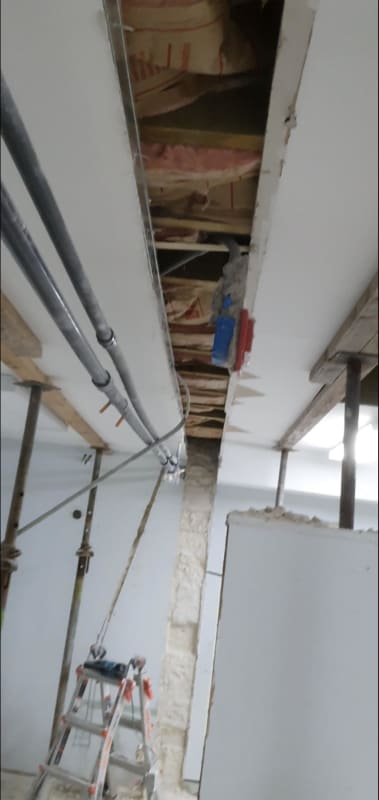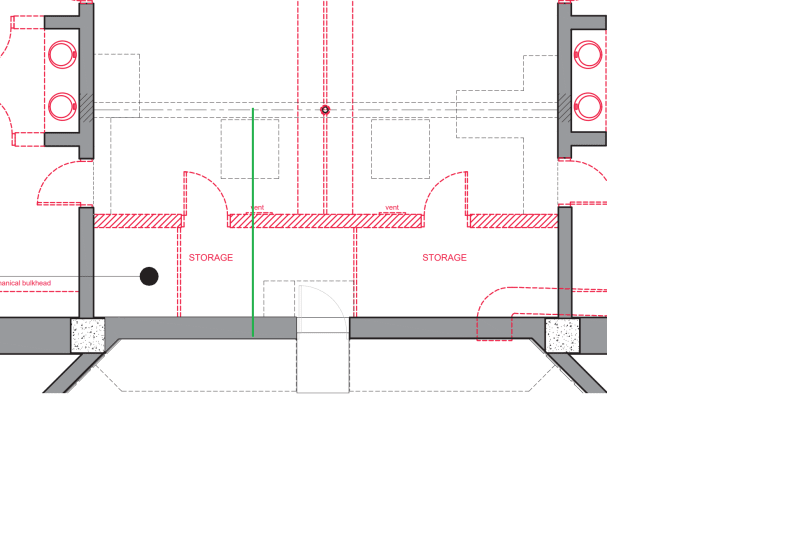Hi there,
A client recently reached out to me with regard to a load bearing wall. Another structural engineer originally specified that the wall be demolished and replaced with a steel beam as it was assumed the existing wall was load bearing.
However, the client said that the contractor demolished the wall and during this process found that there was a gap between the floor joists and top of wall of about 2” (joists were not resting on the wall).
Site photo is shown below :

The client reached out to the original EoR, however, he appears to have left the country and is not answering emails, so they reached out to me to look at the wall instead. They want a report written to confirm whether the steel beam to replace the demoed wall is still required.
If the wall is not load bearing, the floor joists would span between the existing beam and adjacent wall. See below sketch showing the assumed joist span in green and the cmu wall that was demolished in hatched red.

I want to make sure that I am checking all my bases here. So a few things to note/ask :
1. The north beam that the floor joist is bearing on, shown in the sketch above is hidden inside of a drywall bulk head, so I’ll get the contractor to cut a hole so that I can confirm that there is a beam there and that the joists are resting on it. I already saw that the joists were resting on the farthest south wall.
2. Although the contractor and client are claiming that the joists were not resting on the demolished wall. I didn’t see this, as when they called me on site the wall was already demolished. I’ll ask to see if they took photographs of the gap above the wall but what else can be done to verify the claim?
3. I guess if nothing is provided I can measure the cross sections of the floor joists and attempt to determine if the span without the intermediate support (demoed wall) is appropriate, although the floor loading criteria/requirements is unknown.
4. Are there any other considerations I should be making for this?
A client recently reached out to me with regard to a load bearing wall. Another structural engineer originally specified that the wall be demolished and replaced with a steel beam as it was assumed the existing wall was load bearing.
However, the client said that the contractor demolished the wall and during this process found that there was a gap between the floor joists and top of wall of about 2” (joists were not resting on the wall).
Site photo is shown below :

The client reached out to the original EoR, however, he appears to have left the country and is not answering emails, so they reached out to me to look at the wall instead. They want a report written to confirm whether the steel beam to replace the demoed wall is still required.
If the wall is not load bearing, the floor joists would span between the existing beam and adjacent wall. See below sketch showing the assumed joist span in green and the cmu wall that was demolished in hatched red.

I want to make sure that I am checking all my bases here. So a few things to note/ask :
1. The north beam that the floor joist is bearing on, shown in the sketch above is hidden inside of a drywall bulk head, so I’ll get the contractor to cut a hole so that I can confirm that there is a beam there and that the joists are resting on it. I already saw that the joists were resting on the farthest south wall.
2. Although the contractor and client are claiming that the joists were not resting on the demolished wall. I didn’t see this, as when they called me on site the wall was already demolished. I’ll ask to see if they took photographs of the gap above the wall but what else can be done to verify the claim?
3. I guess if nothing is provided I can measure the cross sections of the floor joists and attempt to determine if the span without the intermediate support (demoed wall) is appropriate, although the floor loading criteria/requirements is unknown.
4. Are there any other considerations I should be making for this?
